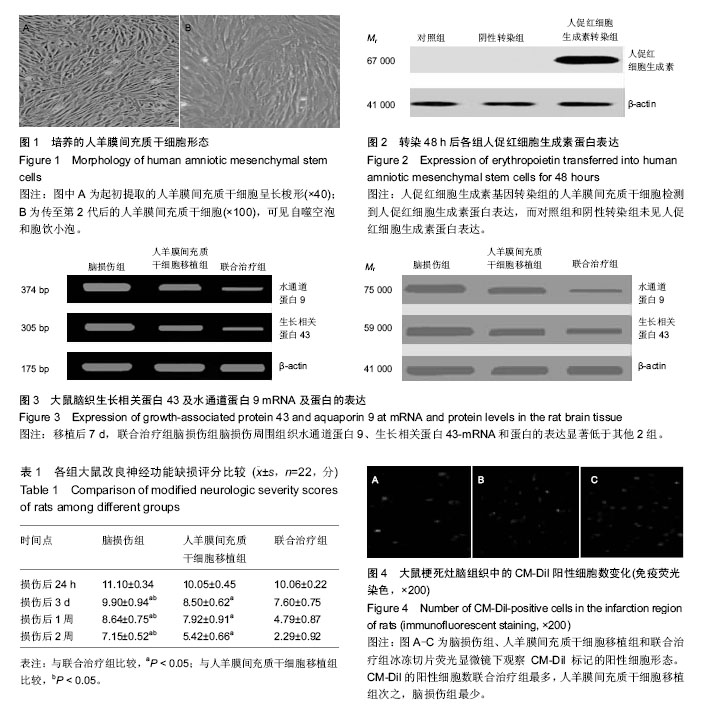| [1] 黄俊海.颅脑外伤的CT影像诊断解析[J].医药前沿,2015, 5(32):80-81.
[2] 张安庆.外伤性脑梗塞28例临床诊治分析[J].淮海医药, 2014,3(4):238-238,239.
[3] 曹莹莹,王晴,陈冰,等.用荧光原位杂交技术检测hEPO转基因山羊染色体上外源基因的整合状况[J].中国比较医学杂志,2003,13(3):132-134.
[4] 冯士军.NGF联合骨髓间充质干细胞移植治疗大鼠脑损伤[J].中国现代医学杂志,2011,21(8):924-928.
[5] Komblum HI. Introduction to neural stem cells. Stroke. 2007;38(2 Suppl):810-816.
[6] 卑贵光,李松柏,马虹,等.脑梗死非溶栓治疗出血性转化的MR分型与预后相关性研究[J].中国临床医学影像杂志, 2011,22(8):533-536.
[7] Bi B, Guo J, Marlier A, et al. Erythropoietin expands a stromal cell population that can mediate renoprotection. Am J Physiol Renal Physiol. 2008; 295(4):1017-1022.
[8] Shiozawa Y, Jung Y, Ziegler AM, et al. Erythropoietin couples hematopoiesis with bone formation. PLoS One. 2010;5(5):10853.
[9] 薛政民,胡萌,张长海,等.不同浓度重组人促红细胞生成素对神经干细胞体外培养增殖的影响[J].中国组织工程研究与临床康复,2011,15(23):4194-4198.
[10] 李宗义,李鹏,高芙蓉,等.EPO修饰增强Müller细胞对RCS大鼠视网膜变性的干预效果[J].中华细胞与干细胞杂志(电子版),2014,4(1):52-59.
[11] 杨智,程春凤,黄昕艳,等.Trizol法提取新生小鼠脑组织总RNA优化比较[J].中风与神经疾病杂志,2012,29(2): 155-156.
[12] 吴洪磊,李洪斌.中西医结合治疗重症颅脑损伤并发肺部感染的临床分析[J].中医临床研究,2015,25(5):120-121.
[13] 韩大明,冯伟.儿童重型颅脑损伤56例临床分析[J].中国实用医刊,2015,42(1):55-57.
[14] 赵建华,张杰文,李玮,等.中枢神经系统结核继发急性脑梗死的临床和MRI/MRA[J].中风与神经疾病杂志,2011, 28(4):364-365.
[15] 刘勤,张红宇,王璐.灯盏花药理作用研究进展[J].云南中医中药杂志,2013,34(2):61-64.
[16] Wu H, Yang SF, Dai J, et al. Combination of early and delayed ischemic postconditioning enhances brain-derived neurotrophic factor production by upregulating the ERK-CREB pathway in rats with focal ischemia. Mol Med Rep. 2015;12(5):6427-6434.
[17] 袁丽丽,杜红梅,管英俊,等.促红细胞生成素体外培养鼠胚脑皮质神经干细胞的分化[J].中国组织工程研究与临床康复,2011,15(49):9174-9177.
[18] 徐颖,凌伟华,陆士奇,等.尾静脉移植羊膜间充质干细胞治疗大鼠脑缺血再灌注损伤[J].中国组织工程研究与临床康复,2011,15(49):9198-9201.
[19] Zhang X, Arnott JA, Rehman S, et al. Src is a major signaling component for CTGF induction by TGF-beta1 in osteoblasts. J Cell Physiol. 2010;224(3):691-701.
[20] Wu MF,Zhang SQ,Gu R,et al.Transplantation of erythropoietin gene-modified neural stem cells improves the repair of injured spinal cord. Neural Regen Res. 2015;10(9):1483-1490.
[21] 张建军,史焕昌,杨卫山,等.亚低温条件下脊髓损伤模型大鼠神经再生微环境及运动功能的变化[J].中国组织工程研究,2015,19(27):4316-4321.
[22] Wang Y, Gang XK, Liu Q, et al. Transplantation of X-box-binding protein-1 gene-modified neural stem cells in the lateral ventricle of brain ischemia rats. Neural Regen Res. 2011;6(1):6-11.
[23] 张志涛,陈彬,白哗,等.缺血缺氧性脑病模型幼鼠脑损伤区神经元电生理特性分析[J].中国医药,2015,10(4): 496-500.
[24] 胡伟,彭亚文,蒋帅,等.自噬在缺血性脑损伤中的作用研究进展[J].中华神经医学杂志,2015,14(5):529-531.
[25] 孙晓全,张瑜,徐清,等.基层医院颅脑损伤的治疗现状与对策[J].临床神经外科杂志,2013,10(5):301-302.
[26] Chang YC, Huang CC. Perinatal brain injury and regulation of transcription.Curr Opin Neurol. 2006;19: 141-147.
[27] 曹健锋,晋鑫,史载祥,等.亚低温治疗创伤性脑损伤的研究进展[J].中华神经医学杂志,2015,14(4):444-448.
[28] Song J, Sun H, Xu F, et al. Recombinant human erythropoietin improves neurological outcomes in very preterm infants. Ann Neurol. 2016.
[29] Barton SK, Tolcos M, Miller SL, et al. Ventilation-induced brain injury in preterm neonates: a review of potential therapies. Neonatology. 2016; 110(2): 155-162.
[30] Lan KM, Tien LT, Cai Z, et al. Erythropoietin Ameliorates Neonatal Hypoxia-Ischemia-Induced Neurobehavioral Deficits, Neuroinflammation, and Hippocampal Injury in the Juvenile Rat. Int J Mol Sci. 2016;17(3):E289.
[31] Kumarasinghe G, Gao L, Hicks M, et al. Improved heart function from older donors using pharmacologic conditioning strategies. J Heart Lung Transplant. 2016.
[32] Robinson S, Winer JL, Berkner J, et al. Imaging and serum biomarkers reflecting the functional efficacy of extended erythropoietin treatment in rats following infantile traumatic brain injury. J Neurosurg Pediatr. 2016.
[33] Skitek M, Jerin A. Proenkefalin A and protachykinin in ischemic neurological complications after cardiac surgery. Med Glas (Zenica). 2016;13(1):8-13.
[34] Hassouna I, Ott C, Wüstefeld L, et al. Revisiting adult neurogenesis and the role of erythropoietin for neuronal and oligodendroglial differentiation in the hippocampus. Mol Psychiatry. 2016.
[35] Kochanek PM, Clark RS. Traumatic brain injury research highlights in 2015. Lancet Neurol. 2016;15(1): 13-15.
[36] Kochanek PM, Bramlett HM, Shear DA, et al. Synthesis of findings, current investigations, and future directions: operation brain trauma therapy. J Neurotrauma. 2016;33(6):606-614.
[37] Millet A, Bouzat P, Trouve-Buisson T, et al. Erythropoietin and Its Derivates Modulate Mitochondrial Dysfunction after Diffuse Traumatic Brain Injury. J Neurotrauma. 2016.
[38] Lv W,Li WY,Xu XY,et al.Bone marrow mesenchymal stem cells transplantation promotes the release of endogenous erythropoietin after ischemic stroke. Neural Regen Res. 2015; 10 (8): 1265-1270.
[39] Yamal JM, Benoit JS, Doshi P, et al. Association of transfusion red blood cell storage age and blood oxygenation, long-term neurologic outcome, and mortality in traumatic brain injury. J Trauma Acute Care Surg. 2015;79(5):843-849.
[40] Gatto R, Chauhan M, Chauhan N. Anti-edema effects of rhEpo in experimental traumatic brain injury. Restor Neurol Neurosci. 2015;33(6):927-941. |
.jpg)

.jpg)
.jpg)